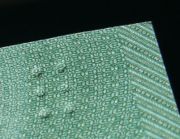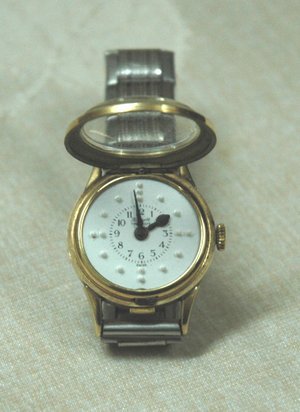Blindness adaptive tools and techniques
|
Blindness Microchapters |
|
Diagnosis |
|---|
|
Treatment |
|
Case Studies |
|
Blindness adaptive tools and techniques On the Web |
|
American Roentgen Ray Society Images of Blindness adaptive tools and techniques |
|
Risk calculators and risk factors for Blindness adaptive tools and techniques |
Editor-In-Chief: C. Michael Gibson, M.S., M.D. [1] Associate Editor(s)-in-Chief: Saumya Easaw, M.B.B.S.[2]
Adaptive Tools and Techniques
Adaptive Techniques

Visually impaired and blind people have devised a number of techniques that allow them to complete daily activities using their remaining senses. These might include the following:
- Adaptive computer software that allows people with visual impairments to interact with their computer via audio or screen magnifiers.
- Adaptive mobile phones that allows people with visual impairments to interact with their phones via audio or screen magnifiers. These mobile phones uses software called Mobile Speak a screen reader from Code Factory http://www.codefactory.es. It provides audio feedback to every functionality on the phone.
- Adaptations of banknotes so that the value can be determined by touch. For example:
- In some currencies, such as the euro, and pound sterling, the size of a note increases with its value.
- Many banknotes from around the world have a tactile feature to indicate denomination in the upper right corner. This tactile feature is a series of raised dots, but it is not standard Braille [3].
- It is also possible to fold notes in different ways to assist recognition.
- Labeling and tagging clothing and other personal items
- Placing different types of food at different positions on a dinner plate
- Marking controls of household appliances
Most people, once they have been visually impaired for long enough, devise their own adaptive strategies in all areas of personal and professional management.
For corrective surgery of blindness, see acquired vision.
Adaptive Tools
Designers, both visually impaired and sighted, have developed a number of tools for use by blind people.
Mobility
Many people with serious visual impairments can travel independently assisted by tactile paving and/or using a white cane with a red tip - the international symbols|international symbol of blindness.
A long cane is used to extend the user's range of touch sensation, swung in a low sweeping motion across the intended path of travel to detect obstacles. However, some visually impaired persons do not carry these kinds of canes, opting instead for the shorter, lighter identification (ID) cane. Still others require a support cane. The choice depends on the individual's vision, motivation, and other factors.
Each of these is painted white for maximum visibility, and to denote visual impairment on the part of the user. In addition to making rules about who can and cannot use a cane, some governments mandate the right-of-way be given to users of white canes or guide dogs.
A small number of people employ guide dogs. Although the dogs can be trained to navigate various obstacles, they are not capable of interpreting street signs. The human half of the guide dog team does the directing, based upon skills acquired through previous mobility training. The handler might be likened to an aircraft's navigator, who must know how to get from one place to another, and the dog is the pilot, who gets them there safely.
Orientation and Mobility Specialist are professionals who are specifically trained to teach people with visual impairments how to travel safely, confidently, and independently in the home and the community.
Reading and Magnification
Most blind and visually impaired people read print, either of a regular size or enlarged through the use of magnification devices. A variety of magnifying glasses, some of which are handheld, and some of which rest on desktops, can make reading easier for those with decreased visual acuity.
The rest read Braille (or the infrequently used Moon type), or rely on talking books and readers or reading machines. They use computers with special hardware such as scanners and refreshable Braille displays as well as software written specifically for the blind, like optical character recognition applications and screen reading software.
Some people access these materials through agencies for the blind, such as the National Library Service for the Blind and Physically Handicapped in the United States, the National Library for the Blind or the Royal National Institute for the Blind|RNIB in the United Kingdom.
Closed-circuit televisions, equipment that enlarges and contrasts textual items, are a more high-tech alternative to traditional magnification devices. So too are modern web browsers, which can increase the size of text on some web pages through browser controls or through user-controlled style sheets.
Computers
Access technology such as Freedom Scientific's [[JAWS for Windows screen reading software enable the blind to use mainstream computer applications. Most legally blind people (70% of them across all ages, according to the Seattle Lighthouse for the Blind) do not use computers. Only a small fraction of this population, when compared to the sighted community, have Internet access. This bleak outlook is changing, however, as availability of assistive technology increases, accompanied by concerted efforts to ensure the accessibility of information technology to all potential users, including the blind. Linux distributions (as Live CDs) for the blind include Oralux and Adriane Knoppix, the latter developed in part by Klaus Knopper|Adriane Knopper who has a visual impairment. The Macintosh OS also comes with a built-in screen reader, called VoiceOver. Later versions of Microsoft Windows include an Accessibility Wizard & Magnifier for those with partial vision.
The movement towards greater web accessibility is opening a far wider number of websites to adaptive technology, making the web a more inviting place for visually impaired surfers.
Experimental approaches in sensory substitution are beginning to provide access to arbitrary live views from a camera.
Other Aids
People may use talking thermometers, enlarged or marked oven dials, talking watches, talking clocks, talking weighing scale|scales, talking calculators, talking compasses and other talking equipment.
